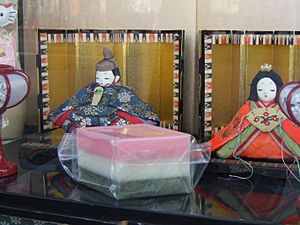Hishi mochi facts for kids
 |
|
| Type | Wagashi |
|---|---|
| Place of origin | Japan |
| Main ingredients | Mochi, fruit of Gardenia jasminoides, water caltrop, Gnaphalium affine |
Hishi mochi (菱餅, ひしもち) is a special Japanese sweet, also known as a wagashi. It is strongly connected to the Hinamatsuri festival, which is also called "Girl's Day." This festival happens on the same day as an old calendar event called Xiuxi.
Hishi mochi has a unique diamond shape. It usually has three layers of mochi, which is a chewy rice cake. The layers are typically red (or pink) on top, white in the middle, and green at the bottom. In some parts of Japan, yellow might be used instead of red. Sometimes, you might even see Hishi mochi with five or seven layers! People often display Hishi mochi with beautiful hina dolls during the festival.
People believe that the diamond shape of Hishi mochi started during the Edo period in Japan. It is thought to be a symbol of good luck and new life.
The Meaning of Hishi Mochi Colors
Each color in Hishi mochi has a special meaning and comes from a different natural ingredient.
Red (or Pink) Layer
The red color in the top layer of mochi comes from the fruits of the Gardenia jasminoides plant. This color represents pretty peach flowers. Peach blossoms are a symbol of spring and good health.
White Layer
The middle white layer is made from the water caltrop plant, which is called hishi in Japanese. This white color stands for the pure snow. It also symbolizes the idea of cleansing and making things fresh and clean.
Green Layer
The bottom green layer gets its color from a plant called Gnaphalium affine. Sometimes, mugwort is used, similar to what is found in kusa mochi. This green color is believed to be very healthy. It is thought to help improve your blood and make you feel better. It represents new growth and vitality.
See also
 In Spanish: Hishimochi para niños
In Spanish: Hishimochi para niños

